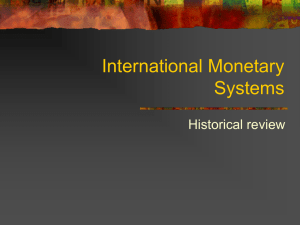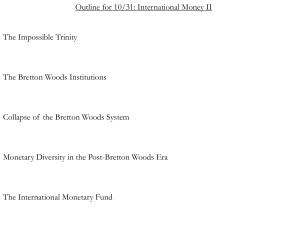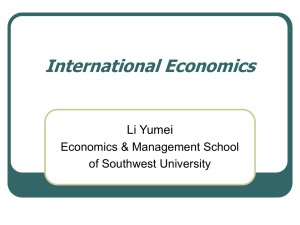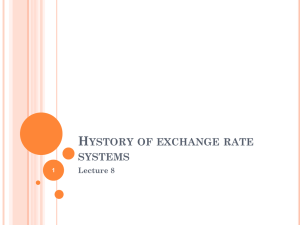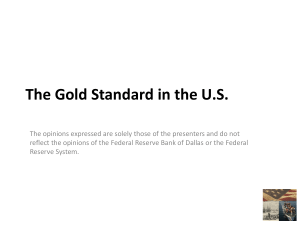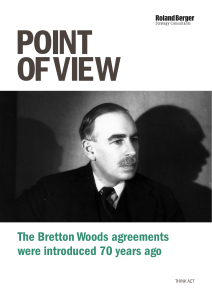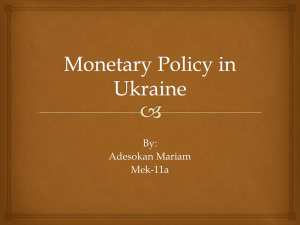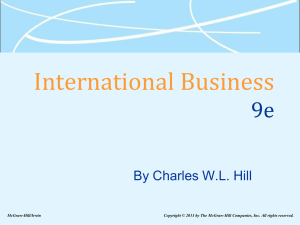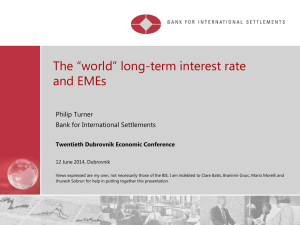The European Monetary System
advertisement
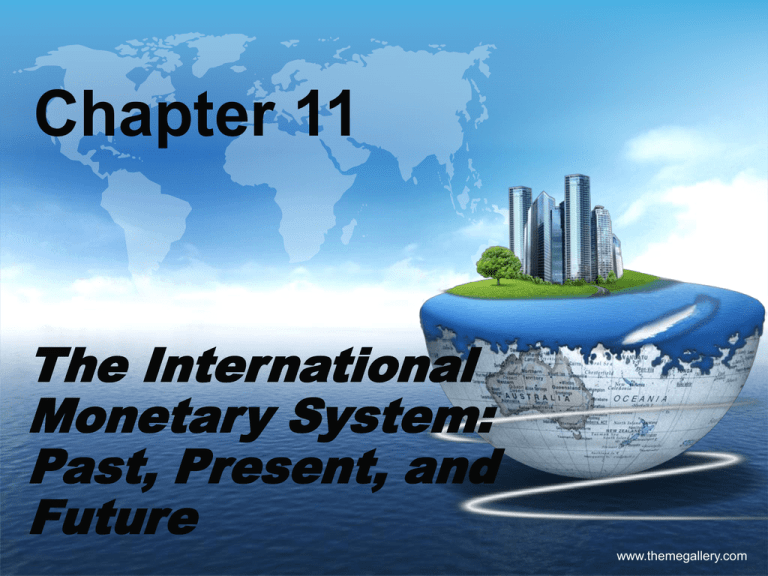
Chapter 11 The International Monetary System: Past, Present, and Future www.themegallery.com Learning Objectives Identify the key characteristics of an effective monetary system. Describe the historical evolution of the international monetary system from Bretton Woods to the present time. Explain the purpose of the IMF and understand its strengths and weaknesses. Differentiate among existing alternative monetary arrangements. Compare and contrast several proposals for reform of the current international monetary system. Introduction International monetary systems facilitate movements of goods, services, and assets. Historically, international monetary systems have differed greatly. The gold standard (1880 – 1914). 1920s: considerable exchange rate flexibility. 1930s: global economic downturn; competitive devaluations and high tariffs limited trade. Bretton Woods: Goals of the IMF To seek stability in exchange rates Reconciliation of country adjustments to payments imbalances with national autonomy in macroeconomic policy To help preserve relatively free trade and payments in the world economy Bretton Woods: IMF Loans When a country joins the IMF, it agrees to pay a quota based on the size of its economy. Member countries can borrow foreign exchange from the IMF in tranches to help with BOP deficits. Additional loans may come with “strings attached” – conditions requiring policy reform or currency valuation changes. Bretton Woods in Retrospect: 3 Problems The Bretton Woods system worked well until the 1960s, when problems began to emerge. 1. Adequacy of reserves (or liquidity) As volume of global trade grows, BOP imbalances will also grow. This demands increases in reserves. The supply of gold was not keeping pace. Bretton Woods in Retrospect: 3 Problems 2. Confidence Slow growth of gold supplies meant countries increasingly held foreign currency reserves (mainly $s and £s). Dollar holdings by foreign countries grew well above U.S. gold holdings, so concern grew over convertibility. 3. Adjustment Certain countries had prolonged BOP deficits or surpluses. These countries were using monetary and fiscal policies in ways that prevented BOP adjustments. Gradual Evolution of a New International Monetary System Early disruptions 1967: U.K. devalued the pound by 14%. Since the pound was a “key currency”, this raised serious doubts about the IMFs exchange rate pegs. 1968: Central banks stopped gold transactions with private individuals and firms. Gold now a “two-tier” market – a private gold market now emerged. This reduced the importance of gold in the international monetary system. Special Drawing Rights (SDRs) In 1970, IMF created a new paper asset called special drawing rights. Countries were allocated SDRs and could use them as international reserves to settle BOP deficits. If a country holds SDRs, it receives interest on excess holdings. Originally 1 SDR = $1. Today SDRs are a weighted average of the values of dollars, euros, yen, and pounds. Breaking the Gold-Dollar Link: the Smithsonian Agreement 1971: U.S. stopped trading gold with foreign central banks. This effectively ended the Bretton Woods System. Later in 1971, the major countries met to work out a new exchange rate arrangement: the Smithsonian Agreement. Initially, countries were optimistic. However, continued currency speculation caused some countries to devalue or even float their currencies. The Jamaica Accords 1976: IMF makes several changes. Each member country can choose its own exchange rate system. Official gold price was abolished; IMF sold off one-third of its holdings. SDRs were to become a more important reserve asset. IMF was to maintain surveillance of global exchange rate behavior and advise members. The European Monetary System 1979: European countries begin to move towards a monetary union. A European currency unit (ecu) was created, functioning only as a unit of account. Exchange rates were to be kept within a narrow band of each other. The European Monetary Cooperation Fund was set up as a proto-European central bank. The European Monetary System: Maastricht 1991: European countries agree to take steps toward the creation of a monetary union in 1999. The European Central Bank (ECB) would serve as the supra-national central bank for member countries. In 1999, the 11 member countries fixed their exchange rates in relation to the euro. In 2002, euro notes and coins were issued. The European Monetary System: Maastricht “Euroland”: Austria, Belgium, Finland, France, Germany, Ireland, Italy, Luxembourg, the Netherlands, Portugal, and Spain This system required convergence criteria: Inflation rates could not be too high. Long-term government bond interest rates could not be too high. Government budget deficits could not be too high. Government debt must be kept in check. The European Monetary System: Maastricht Convergence requirements presented major challenges. In the end only Greece was denied admission to the EMU (it later was admitted). Denmark, Sweden, and the U.K. elected not to join the EMU. Giving up sovereignty over monetary policy and giving up their domestic currencies were too great a step for these countries. The European Monetary System: Early Results The transition to the euro went smoothly and was popular with citizens. Elimination of exchange rate and lower transactions costs has created new opportunities and has enhanced efficiency. The euro has helped further financial integration. The euro is the world’s second-most widely used currency. The European Monetary System: New Entrants European Union has added many new countries in the past decades. Once they meet convergence criteria, countries can apply to join the EMU. Slovenia was admitted in 2007. Slovak Republic was admitted in 2009. Since Bretton Woods: A Summary Fluctuations in the exchange rates among the major currencies have been very large since the Bretton Woods system fell apart. Since Bretton Woods: A Summary As a result, international competitiveness has varied considerably, with substantial dislocations in export and importcompeting sectors of countries. Current Exchange Rate Arrangements As of 1978, IMF member countries have the right to have whatever exchange rate systems they wish. A number of distinct exchange rate arrangements now exist, ranging from no flexibility to total flexibility. Sometimes this non-uniform collection of arrangements is called a “non-system.” Current Exchange Rate Arrangements Arrangements with no separate legal tender (a country uses the dollar or some other currency as its own) Complete absence of exchange rate flexibility 10 countries have adopted this, e.g. Micronesia and Panama. Currency Boards (currency is fixed in value against an anchor currency) Ms can only increase if anchor currency holdings increase. 13 countries, e.g. Bulgaria and Dominica Current Exchange Rate Arrangements Conventional Pegs (minimal variation is allowed around a parity value set against a foreign currency) Pegs against the dollar: 36 countries, e.g. Argentina, Malawi Pegs against the euro: 20 countries, e.g. Denmark, Niger Pegs against other currencies: 5 countries, e.g. Lesotho, Bhutan Pegs against a composite basket of currencies: 7 countries, e.g. Libya, Russian Federation Current Exchange Rate Arrangements Other pegs, including crawling pegs (greater variation is allowed around a parity value set against a foreign currency) Horizontal bands: 3 countries, e.g. Syria Crawling pegs/crawling bands: 10 countries, e.g. China, Iran Managed floats (currency floats with occasional intervention) 44 countries, e.g. Egypt, Uruguay Current Exchange Rate Arrangements Floats (the value of currency is determined by markets with only rare intervention) 40 countries, e.g. the EU, Mexico, the U.S. Experience Under the Current International Monetary System The international monetary system for industrialized countries can be characterized as a managed float. What is the consensus about the operation of that system? Experience Under the Current International Monetary System 1. The international monetary system has been characterized by substantial exchange rate variations. 2. Exchange rate overshooting (discussed in Chapter 22) has occurred. 3. Exchange rate variability has had real effects: nominal rate fluctuations have not matched PPP exchange rate variations, so real exchange rates have fluctuated. 4. The system hasn’t insulated countries from foreign shocks as well as was hoped; perhaps because of intervention. 5. Countries have increased their holdings of international reserves; a flexible exchange rate system was supposed to allow reduction. Particular concern: some central banks (esp. China’s) now have enormous dollar reserves – selling these would cause a dramatic decrease in the dollar’s value. 6. There has not been an increase in inflation because of greater flexibility of exchange rates (the “vicious circle” hypothesis of Chapter 28 hasn’t come to pass). 7. More flexible exchange rates do not seem to have caused the volume of trade to shrink. 8. The Asian financial crisis of 1997 was fueled by speculative overinvestment inadequate institutional development and oversight ease of capital flight from one country to another The Global Financial Crisis and Recession of 2007-? The world’s worst recession since WWII began in 2007 with the onset of the collapse of the U.S. subprime market. The downturn quickly spread to other countries. In response, governments have used expansionary fiscal and monetary policy; IMF has attempted to help developing countries. The Global Financial Crisis and Recession of 2007-? Who’s to blame? Fingers have been pointed variously at: Financial institutions that took dangerous risks. Regulatory agencies that allowed reckless behavior. Large global imbalances, such as the U.S.’s large and persistent current account deficits and China’s surpluses. At present, the severity and duration of this recession are unclear. Suggestions for Reform of the International Monetary System A return to the gold standard Long-standing BOP imbalances would not occur, and exchange rate risks would be reduced. However, this system emphasizes BOP equilibrium over internal goals such as full employment. A world central bank Extreme form: something like the EMU Which country would give up its sovereignty? Suggestions for Reform of the International Monetary System The target zone proposal Major countries would negotiate targets for real effective exchange rates; each country would commit to maintaining this value within a range around the target. It can be difficult to manage real exchange rates, and some argue that such a system would interfere with efficient resource allocation. Suggestions for Reform of the International Monetary System Controls on capital flows If speculative capital flows cause instability, minimize them perhaps by a “Tobin tax.” But capital flows can increase economic efficiency, and so economists typically oppose capital controls. Suggestions for Reform of the International Monetary System Greater stability and coordination of Macroeconomic Policies Across Countries Macro policies for a particular country can be unstable over time, and countries’ macro policies are sometimes at cross-purposes. It might therefore be sensible to make a greater effort to coordinate policies. Such coordination might be difficult to operationalize. The International Monetary System and the Developing Countries Less developed countries (LDCs) generally prefer fixed exchange rate systems, and they wish to avoid the exchange rate volatility of the postBretton Woods world. However, fixed exchange rate systems require adequate international reserves, so LDCs want any reform to address this. The International Monetary System and the Developing Countries LDCs are also concerned about IMF “conditionality” – the strings that are attached to any LDC use of IMF resources. LDCs want an international monetary system that will generate more stability. LDCs would like a greater voice in organizations such as the IMF and the World Bank. Add your company slogan www.themegallery.com
